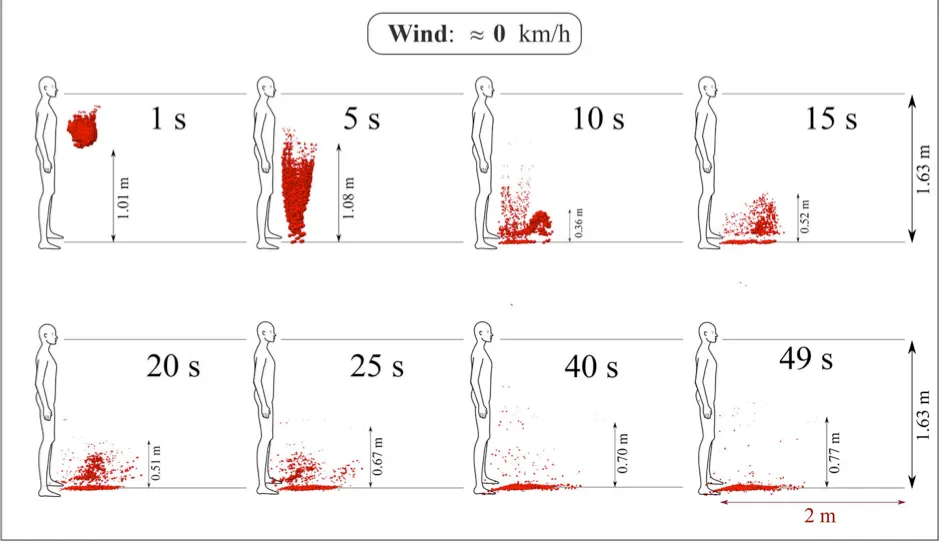Staying two metres apart may not be far enough to stop outdoor coronavirus transmission, a study has suggested.
Research from the American Institute of Physics has found saliva droplets can travel more than five metres in five seconds if there a slight breeze of around 4kph (2.5mph).
Professor Dimitris Drikakis, one of the authors of the study published in the journal Physics of Fluids, said shorter adults and children could be at greater risk if they are near the trajectory of the droplets.
He added: “The droplet cloud will affect both adults and children of different heights.”
Read more about the transmission of coronavirus:
- Coronavirus: Should we all wear face masks?
- Can I get the coronavirus from a parcel?
- Can my dog get coronavirus?
The researchers looked at computer simulations of how coughing would cause saliva droplets to move through air, taking into account the way they disperse and the interactions of molecules of saliva and air.
Their simulation also considered the effects of humidity and temperature of the surrounding air.
The team wrote: “Without surrounding wind speed, the droplets will fall to the ground in a short distance from the person exhaling or coughing. The present analysis shows that the range may not exceed one metre.
“At wind speeds from 4kph to 15kph, we found that saliva droplets can travel to distances up to six metres with decreasing concentrations and liquid droplets size in the wind direction. Our findings imply that depending on the environmental conditions, the two metres social distance may not suffice.”
They add that further studies are needed to determine the effect of ground surface temperature on the how saliva travels in air.


Simon Clarke, associate professor in cellular microbiology at the University of Reading, who was not involved in the study, said: “The fact that droplets from a cough can travel for more than two metres is already understood, but this new study helps to provide more insight into the physical mechanisms at work as droplets travel through the air.
“This is a reminder that the two-metre rule is recommended, not because staying two metres away from all other people provides you with a force field against infection, but because it is a reasonable distance to stay away from people to reduce risk of infection.”
He said that while staying two metres apart is better than keeping a one-metre distance, the protective effect of this measure is “not proportional to the distance”.
Dr Clarke added: “The most important point to take away from this paper is not that we need to change guidelines on social distancing, but that coughing is one of the best ways to spread infected droplets if you’re ill.
“So if you have a cough, stay at home until you’re better – and if you cough unexpectedly when you are out and about, cough into your elbow. Then go home and stay there.”
What is the R number, and why is it relevant to coronavirus?
The reproduction number – often called the R value or R number – is a measure of a disease’s ability to spread. It tells us how many people a single infected person will pass on the disease to.
The R number for COVID-19 that’s being quoted in the media and government briefings is what’s known as the ‘effective’ reproduction number. This value can go up and down.
We can reduce R by making it harder for the disease to spread, by implementing measures such as social distancing, closing restaurants and non-essential shops, and encouraging people to stay at home.
Every disease also has what’s called a ‘basic’ reproduction number, R0, which is the fixed value of R if no measures are put in place. For example, measles is highly contagious, with a R0 as high as 18, while COVID-19 has a R0 of around three.
So if COVID-19 was allowed to spread through the population, an infected person would, on average, give the disease to three other people.
But if all these people are practising physical distancing, then the virus can’t spread so easily and the effective R value goes down.
The crucial thing is to keep R below 1. If we can do this, then the number of new cases dwindles and the outbreak will eventually come to a halt.
Conversely, if R rises above 1, then we run the risk of rapidly escalating case numbers that would require stronger measures to keep the virus under control.
Because of this, R is used by governments to assess how we are doing in our efforts to stop the spread of COVID-19, and to adjust our actions, if needed.
Read more:
